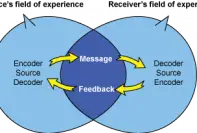Interactive model (also known as convergence model) deals with exchange of ideas and messages taking place both ways from sender to receiver and vice-versa.
The communication process take place between humans or machines in both verbal or non-verbal way. This is a relatively new model of communication for new technologies like web.

Components of Interactive Model
Interactive Model of Communication requires different following components for the communication process to work:
- Encoder-Source-Decoder: The person who originates a message is the source. The encoder and decoder are the same person/source. The second source is also encoder as well as decoder. The source acts as an encoder while sending the message and as decoder while receiving the message.
The second source decodes the message, then originates another message, encodes it and sends it to the first source. The source is known to be encoder and decoder during the act of encoding and decoding. - Message: Message is the information sent during the interaction.
- Feedback: The decoder forms a second message after receiving the first which is known as feedback.
- Field of Experience: Field of experience is the experience and knowledge that the source possess which affects the message formation and interpretation. For example, the source’s culture, social behavior, etc.
Concepts of Interactive Model
In Interactive model, whenever a source sends a message to a receiver (source), he/she encodes the message first. The encoded message is then received by the receiver where it is decoded to get the original information. Again, the receiver acts as a source, encodes another message (also knows as a feedback) and sends it back to the sender.
The message formation of both sources are affected by their “field of experience”. Field of Experience is a communication pattern alteration factor like culture, social, psychology, situation and channels used. Overlapping field of experiences initiates conversation and conversation, in turn, expands the communicator’s field of experience. All these factors also affect the message interpretation.
The model also has a concept of noise and barriers to communications like language, network problems, etc which affects the communication process. There is an open line of communication in interactive communication model. Being interactive is taken to be a very important aspect of effective communication.
Interactive Model Examples
Internet can be taken as the best way of interactive communication as receiver can give feedback even in newspapers and books. Internet has increased the opportunity of interactive communication and it is still evolving.
Human-computer interaction is also now considered as interactive communication as the model is circular where the senders interchange every time. Social media, interactive marketing and user generated contents, ATM machines, online shopping, chat rooms, etc are other examples of interactive communication model.
Criticisms of Interactive Communication
- Feedback is not simultaneous and can take a long time as this model is mostly used for internet.
- Communication is not taken as dynamic. It predicts communication to follow the same pattern always.
Interactive Model and Other Models Differences
| Interactive Model of Communication | Other Models of Communication |
| Indirect and slow feedback | Direct and fast feedback |
| Feedback is a whole new process of communication | Feedback is the part of a single communication process |
| For new media | For all other kinds of media like print, news, etc. |
| No engagement of sender and receiver in communication | Engagement of sender and receiver in communication |
| Sender and receiver is equally important | Sender is important and overpowering than receiver |
| It can become linear if the receiver does not respond | The receiver is bound to give some kind of response verbal or non-verbal |
